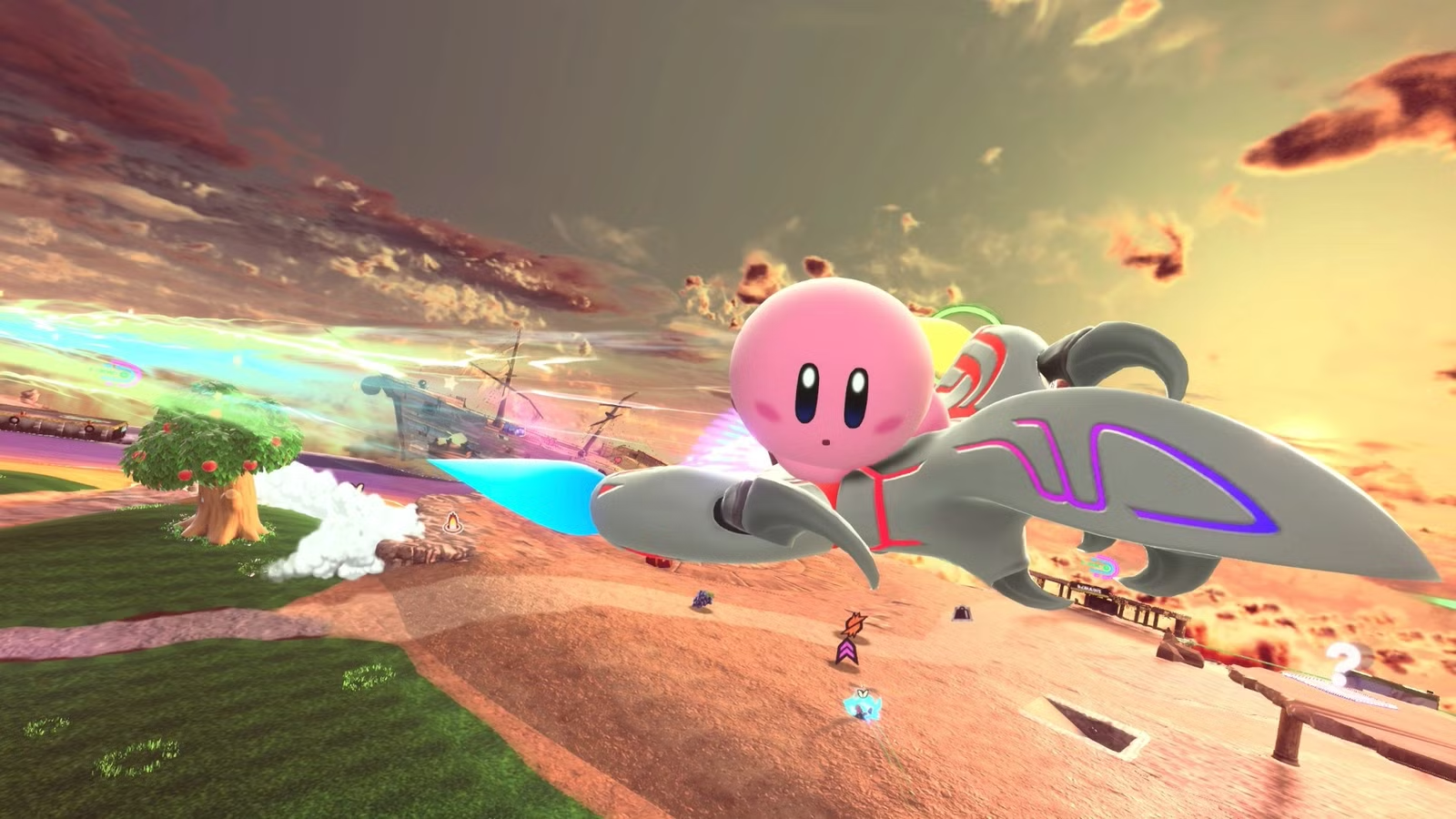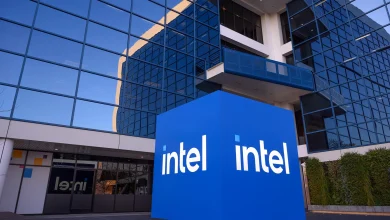Kirby Air Riders is a chaotically whimsical nod to an easier time

Like many kids who grew up in the 2000s, I spent weekends at my friend’s house glued to their GameCube. We’d alternate between multiplayer titles, but the one we spent the most time on was Kirby Air Ride, a quirky racing game from 2003. It wasn’t a household staple like Mario Kart: Double Dash!!, but rather a quieter, “If you know, you know,” type of game.
We’d sit on the floor, looking up at the massive living room TV, completing every box on the in-game checklist of achievements. Once we were done, we moved the save file onto my memory card (Remember when you could do that!?), and spent hours upon hours roleplaying different scenarios on the various maps in the game, soaring around on Flight Warp Star, and seeing how quickly we could expertly collect both legendary machines in one City Trial round.
To me, Kirby Air Ride was the perfect game. It represented innocence, placing me in a time where I had no responsibilities and could just revel in joyous fun. Kirby Air Riders takes that original whimsy and cranks it up to 11, mixing in more chaos to create a flashbang of nostalgia and fun.
Image: Bandai Namco Studios, Sora Ltd./Nintendo via Polygon
Kirby Air Riders is a high-speed racing game, but it’s not like Mario Kart. Your vehicle (called “machines”) will move forward automatically; you just need to steer it. Pressing A or B will actually force your machine to halt completely, but also charge up a boost, making it a great way to gain an advantage on sharp turns. During the races, you’ll be able to ride on the starry trails of the players in front of you, suck up enemies to gain copy abilities (as you would in any Kirby game), and take in the sights around a bunch of unique courses, some new to this game and some remade beauties from the original game.
There’s also a commonly ignored game mode called Top Ride, where you take on races from a bird’s eye view of the course, making laps around smaller race tracks from above. Top Ride is quirky and cute, but it’s the weakest of the game’s offerings — just as it was in Kirby Air Ride.
The straightforward racing is great, but if you ask any Air Ride fan, they’ll tell you that the bread and butter of the series is the City Trial mode, which gives you five minutes to dart around a small open-world area, picking up power-ups and seeking out stronger machines for you to compete with in a minigame with at the end. Whoever wins that challenge gets all the marbles, but the minigame can be focused on a wide range of activities — racing, combat, or even gliding — so you’ll want to create a fine-tuned machine to be able to win it all.
When I played this game as a kid, I used the Shadow Star (which I always called the Batmobile) for everything. I’d brute-force it into every situation of the game and win — not just because I loved how it looked, but because it was a powerful machine. In Air Riders, everything has been rebalanced the way its creator, Super Smash Bros. mastermind Masahiro Sakurai, intended. The Shadow Star’s days of terror are over. It was obvious enough in the limited online play tests (both the Global Test Ride, which offered a limited version of the City Trial, and a media session hosted by Nintendo), but it was confirmed further in the new single-player Road Trip story mode.
Image: Bandai Namco Studios, Sora Ltd./Nintendo via Polygon
In Road Trip, you ride along on a path, picking between three options presented in front of you (like every good, modern video game nowadays). The options can vary between items and stat bonuses, but you’ll mainly be picking different challenges based on the aforementioned game modes to complete. There are, in true Sakurai fashion, beautiful cutscenes every few levels, telling the story of how the vehicles came to be, but the narrative mostly unfolds as short interludes between bite-sized challenges.
The early levels were pretty easy (even on the hard difficulty), but as I got deeper into the campaign, the Shadow Star was not keeping up anymore. I did have to change to the beefier Rex Wheelie for some of the racing levels, or one of the new tank-type machines for ones where I had to take on a lot of enemies. That all makes sense to me, as you cannot make a modern multiplayer game without balancing the options out — especially when one was so obviously dominant in the previous version. Even so, it made me a little sad to shelve my Shadow Star.
From the trailers alone, I knew so many things would be changed — hopefully improved — but remained hesitant: Would those tweaks actually be for the better? Or would they drive me to turn away from the formula I loved so much already? I was apprehensive when Sakurai showed off the new City Trial map, an island named Skyah, that brings back elements from the last game’s map. It’s a city with buildings in the center, an underground garage, a small forest, a volcano… I felt like my original home had been replaced, but I cannot stress enough how much everything has been upgraded here. I remember making discoveries when I played the game as a kid, showing my friends the cool area under the woods that had dioramas of the buildings, or how the rail under the volcano takes you through a wall.
That whimsy has been replicated on this new map, which can change and shift a bit every time you play. I have literally gone, “HUH?” out loud multiple times as I find new things or figure out better strategies to reach certain areas, and it does feel like… well, I’m a kid again. I don’t think I’ll spend my time roleplaying in the free-roam mode the way I used to, but I will be using my newly discovered techniques to get a leg up on my friends. (Though I’ve talked about the map during the Global Test Ride with my friends and I’ve already heard the phrase, “Oh, I’ve been doing that,” so let’s just say the gauntlet will be thrown down once this game launches for real.)
Image: Bandai Namco Studios, Sora Ltd./Nintendo via Polygon
Everything in this game feels like a carefully measured decision made solely either to provide new joy or let you discover it more easily through gameplay improvements. The camera quickly zooming on your character after you buy a hat, thus dramatically showing you a hamster with a weather vein on its head? Joy. The ability to fuss with the settings, allowing you to cater the game mode to what you want it to be? Gameplay improvement. Collecting gummy versions of the vehicles that serve no purpose other than knocking them around in a sandpit? Joy. The fact that the machines approach you in City Trial if you’re without a car, as if they’re trying to help you out? Hmm, both gameplay and joy, probably.
There are many moments where the game gets out of control — which could be a good or bad thing, depending on how much you like to smash into walls. If you spend all your time picking up every power-up you can, by the end of the City Trial run, your vehicle will likely be unwieldy, smashing into every barrier and obstacle in its path at top speed. While this can be great for Drag Races and some of the other Stadium challenges, most of them will be substantially harder if your machine has dogwater handling. This forces you to take a slightly more measured approach — rather than grabbing everything, you need to make sure you’re being somewhat smart about not overloading your machine.
But that chaos is also what makes it fun. I have clips of me running through characters lightspeed as Rick, killing them instantly, as if this gerbil was A-Train from The Boys. If I lose a City Trial because my vehicle is overloaded, that’s OK, because I’m just going to queue up for the next one and maybe this time I’ll be smart enough to not pick up 15 “top speed” buffs (but I’ll probably do it again). In fact, I’ll use the magnet item to massively suck up every power-up I possibly can while also smashing into my poor rivals to suck up their buffs, too.
Image: Bandai Namco Studios, Sora Ltd./Nintendo via Polygon
Embracing the chaos of City Trial feels cathartic, like I’m in a Kirby-themed rage room. I’m smashing through boxes and ruins, obliterating any players that are unfortunate enough to cross my path. I’m shooting myself out of a volcano and firing huge laser cannons and beating up giant birds that fly down from the sky. I’m throwing out bowls of curry that’s too spicy for my opponents to handle, so they get hurt when they touch it. I’m ominously murmuring, “I’m gonna getcha,” quietly to my friend who is labeled on the map because they have a legendary air ride machine piece that I need to complete my set of three. I’m slamming my fist on my desk and yelling when my friend does the same thing right back to me.
But that’s the other thing — even though so much of this game is spent in chaotic moments where I’m gnashing my teeth, gripping my controller hard enough to snap it in half, there’s a whole different part of the game that’s serene. I’ve spent an equal amount of time sunken into my couch in handheld mode, just completing races and challenges with goals in mind, trying to check off another box on the huge list of in-game goals (750 boxes total!). I spy a challenge box that’ll reward me with a new character and immediately queue into a new round, in hopes that I can score 80 points in a single Gourmet Race stadium challenge — a minigame where you have to eat as many photo-realistic foods as possible. Yes.
There is mayhaps no sound as satisfying as finishing a stage in Kirby Air Riders and hearing the slamming sound effect of a handful of checkboxes getting filled in. The dopamine rush it gives me every time is amazing. Even in the short multiplayer session I played, seeing the various boxes check off after each online battle reminded me of sitting and working through the list as a kid.
I think I will spend many hours unlocking all the boxes and discovering new secrets with my friends, bringing me full circle back to my childhood, as if I am the food critic Ego from Ratatoullie, taking his first bite of the titular dish. Things are different now. I won’t be rushing to grab my Shadow Star every time. I certainly am too old to be sitting on the floor, breaking my neck to look at my TV screen. Thankfully, Kirby Air Riders provides the familiar magic that the original game did, turning me back into a kid on a lazy Saturday afternoon with my friends.





